
Adventure Update- February 2008
Back to January update February 4 February 10 February 16 February 18
February 22 March 11
___________________________________________
February 4
Pam called me (Nancy) on her satellite phone to say that they are in Mali, camping in Timbuktu. They are near the town of Gau. They are heading to Dakar, Senegal, and will send an update when they find an internet cafe. Everyone is safe and well!
For more information, go to John's February 5 diary entry!
Also look here for photos of the group at confluence, courtesy of John.
___________________________________________________________
February 10
Karl takes Max, his Gelandewagen, to Mercedes for repairs. The girls and Garth visit the Village des Artisanal de Ouagadougou, an up market workshop where artists create jewelry, leatherwork and fabrics. We all enjoyed ourselves because there was not the normal pressure to buy the crafts….so of course we bought a few items. Gail had the experience of having her hair tinted at a local hair salon and we were all impressed with the result. We also enjoyed the best pizza that we have ever eaten…ANYWHERE! Who would have thought!
.
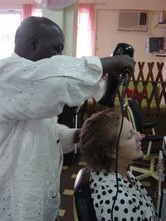
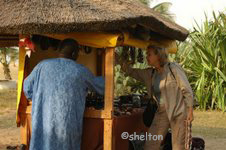
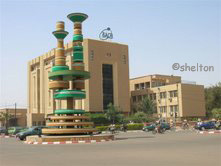
Gail getting a hair tint.... Gail looking at jewelry...... weird buildings in Ouagadougou
Our exit out of Ouagadougou is made difficult by Police Officers who stop and fine 2 of our drivers for various so called “offenses” such as talking on our radio. Matt negotiates a small bribe and Karl just drives off in disgust.
We experience the fierce dust of the Harmattan wind as we drive which sends clouds of dust which obscures the scenery. Motorcyclists ride at precarious angles and boys help their donkeys pull heavy carts against the wind.
Our lunch stop reveals 2 vehicle problems. Timbuktu, Diers’ Landcruiser, has a damaged water pipe leading from the water storage tank. 60 litres of precious water has leaked out. This is a crisis as water in a desert environment is of vital importance. Max, the Gelandewagen, is leaking diesel from its reserve tank and needs to be welded. These repairs will have to wait until we get to a large town.
We spend the next two nights camping in the bush and enjoying the wonderful sunset and then a campfire. This is probably our favorite lifestyle. .
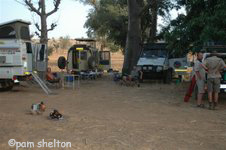
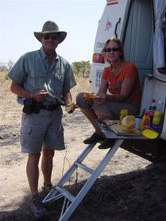
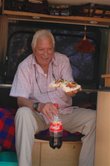

Bush camp..... ....Garth and Gail have lunch.........Juno with favorite lunch...... Matt in his office
MALI
At this point we decide to appoint one person to deal with our Carnets (our vehicle passports) and one to handle all our personal passports. This prevents all of us needing to crowd into the small customs office.
Despite the presence of the Niger and Senegal Rivers through the Western tip of the country, much of Mali lies in the Sahara. The Bamana people are the largest tribe. The Tuareg, the Fula, Bela and Fulani are the nomadic groups living near the sparsely spaced oases of the Sahel. The road from the border is tarred, with potholes occasionally filled with sand, making the driving difficult.
Djenne
We cross the Niger River on a ferry to the famous Heritage Site of Djenne. Entering the town one feels as if you have gone back in time to the 15th century. The people live in square mud Sudanese houses joined by narrow alleyways. A scene of donkey carts, goats, markets and piles of rubbish flash before our eyes and noses. Djenne is famous for its exquisite Grand Mosque, the largest mud mosque in the world which is remudded each year after the heavy rains by the local people. The attack of aspiring guides is all too much and we decided we needed a resting place outside of town. The hotel Djenne Dijano suits us perfectly. We can sleep in our vehicles while hiring one room for its shower and bath. We eat by candlelight in the open courtyard enjoying the ambiance of the desert. We explore Djenne in the early morning light and take hundreds of photographs of the mosque and people.
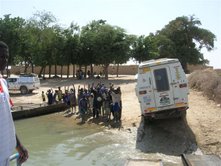
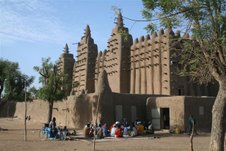
Ferry crossing.......... Djenne Grand Mosque
The Dogon Country of Mali
We pass the riverside town of Mopti heading for Bandiagara Escarpment where we camp at Togona Campsite. We hire an accredited guide named Ouseman, who will take us on a 3 day trip to visit the famous Dogon people who live along the Escarpment. Ouseman is a Dogon himself so he is able to answer our every question regarding the Dogon customs and history. .

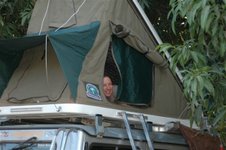
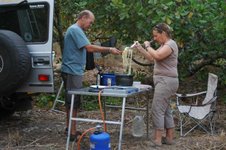
Camping in Dogon country............... Erna at dawn.................. Erna and Karl making dinner
The Dogon arrived at the escarpment in the 15th century. They migrated there to preserve their traditional animist (voodoo) tradition in the face of Muslim expansion.
The original occupants of the Escarpment were the Tellem who arrived in the 11th century. They were said to be pygmies and their distinctive Cliffside cellular houses are still visible above the Dogon villages. The dwellings remain unoccupied because the Dogon believe the Tellem had the magical power to fly and their homes are sacred and unreachable.
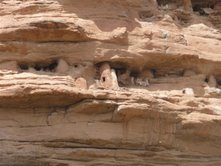
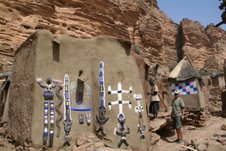
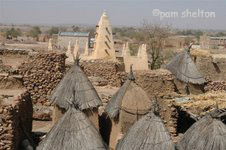
Dogon village
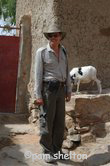
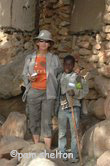
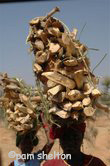
Garth and Gail at Dogon village...... lady carrying wood
The three days we spent driving, and camping, in Dogon country in searing heat, climbing steep rocky paths to visit the villages make us realize the harsh conditions in which the Dogon live.
As we left Dogon country and head up onto the escarpment’s difficult rocky paths, we pass donkey carts straining to carry their heavy load of millet and often goats wrapped in plastic with only their heads showing, on their way to market. Chickens never really get a chance to see the sky as they always seem to be carried upside down by their feet, eyes staring at the ground. .


Goats wrapped in plastic ........ big donkey load
As we near the town of Douenza, we start to see nomadic Tuareg herding their cattle, often riding camels.
TIMBUKTU
We now begin the 195 km trek on sandy corrugated road to the mythical town of Timbuktu. We pass many Fulani people herding their cattle through the dry Sahara. They are dressed in traditional jellabas (men’s dress) and turbans.
Then a problem occurs when Max’s diesel tank splits and loses 25 litres of fuel. The temperature is over 41c and we are too tired to go on so we set up an early bush camp. Some ice cold beers and whiskeys put us in a mellow mood very quickly.
We wake up to a pale peach glow and for once we don’t have an audience. We continue on our journey to Timbuktu. At one of our morning breaks we have the wonderful experience of a nomadic Tuareg family crossing the desert beside us with a train of camels. It is a memorable moment for all of us and almost feels like we are part of a movie scene.
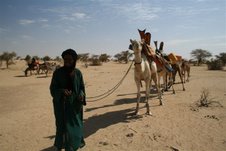
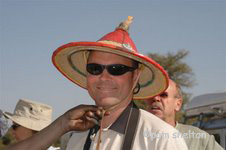
Tuareg family with camels........ Matt in Fulani hat
We arrive at a ferry which took two trips to get all 5 vehicles across. Finally we arrive at Timbuktu!
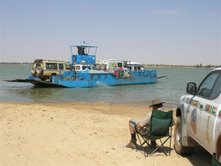
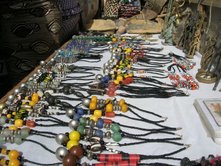
Ferry crossing........ Jewelry display
We camp at the Le Paix campsite. Taureg invade the campsite selling their handcrafted jewelry, swords and leatherwork. They are the most respectful and courteous salesmen and we all fall under their spell.
We find Timbuktu to be an ordinary Malian town with mud houses and mosques. We hire a guide who shows us the famous mosques, libraries containing old valuable manuscripts and the new library being built by South Africa. As we leave Timbuktu, we photograph our vehicles beside the 4 km milestone. Diers’ vehicle, which they named Timbuktu, is now officially christened Timbuktu .
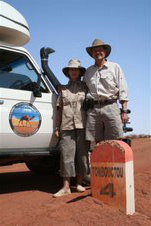

Garth and Gail with Timbuktu at Timbuktu.....Stallion stuck in mud.......
We decide to take the scenic route south to Mopti through the Niger River Delta. We are told that the river level has subsided and the road is passable. Unfortunately, after we crossed on the ferry we discover that the road is not usable and we nee to bushwhack our way south through 5 villages whose names are scrawled on a paper for us. This track wanders throughout the delta, passing palm groves, cattle grazing areas and dry pans. We travel for 2 days between the desert and the Niger delta. The heavy summer rains have swelled the delta causing us to need 4 separate ferry crossings. The sand tracks are so confusing we have to hire local people to guide us through certain sections. We camp in the dunes with camel grass sprouting all around us. We have had the most amazing desert experience imaginable. .
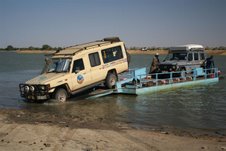
Ferry crossing
We are on our way to Bamako where we will apply for Senegalese and Mauritanian visas. We have traveled 9,500 kms to date.
Bamako is a sprawling city and we have great difficultly locating a suitable hotel and we find ourselves lost in a huge street market. We eventually settle at Le Relais Hotel where thankfully we can have a decent shower, do our washing, clean our vehicles and access the internet. Matt and Dave leave at dawn for Dakar (Senegal) to return to South Africa and Slowy and Charles will join us in Dakar on the 18th. .
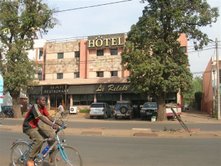
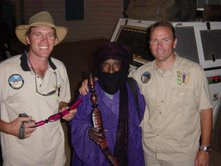
..........Hotel Le Relais....... Dave and Matt making a deal
Monday morning we apply for our visas and hope to be on the road to Dakar on Tuesday.
Return to top
_____________________________________________________________________
11 February onwards
The break at Le Relais Hotel in Bamako, Mali, is a much needed one, where the group can spend time relaxing and enjoying delicious meals cooked by someone else.
Erna is able to organize her visa for Senegal (she is Swiss) but we run into a total block at the Moroccan Embassy where Garth, Gail and Juno apply for visas. The Consul refuses to issue visas for South Africans until they obtain a letter of introduction from the South African Embassy addressed to the Moroccan Embassy. The South African Embassy makes one proud to be South African. The South African flag flies high in Bamako and the Embassy makes one feel as if you have come home when they offer tea and suggest to always visit the Embassy when traveling through different countries. The required letter is issued and we return to the Moroccan Embassy. To our dismay, the Embassy will not issue visas to South Africans (note that the other members of our group do not even NEED a visa in Morocco) and the Consuls only suggestion is that we visit the Moroccan Embassy in Dakar and try our luck there.
LEAVING FOR DAKAR, SENEGAL
We leave Bamako, the hot, dusty capital of Mali and head to Dakar, Senegal. The road is tarred and runs through the dry Sahel. The downside of a road like this is that we cannot interact with the people or interesting sights along the way. We travel down the escarpment and pass heavy trucks labouring up the hill, often breaking down. Drivers then make camp alongside their trucks in the hope that someone will assist them. We bushcamp alongside the mountains in the hope that we will have an evening without onlookers and yet people appear from nowhere and stop to greet us. One evening the Harmattan wind blows fiercely and Garth takes to wearing his ski goggles to protect his eyes.
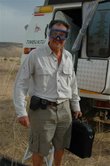
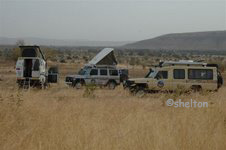
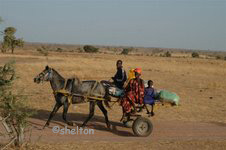
Garth in goggles.......... camp in Senegal.......................Family on way to market
We pass through villages where rubbish has been building up for many years untouched. These are communities where concern for their environment is much less important then basic survival. Goats, sheep and cows graze on the rubbish piles and seem to thrive on the plastics.
We exit Mali and enter Senegal without undue delay. It is 600 kms from the Mali/Senegal border to Dakar. 200 km to the town of Tambacounda is tarred and fast. We then need to tackle 150 km of one of the worst potholed roads we have ever driven. Tankers and heavy trucks weave like Dodgem cars trying to avoid closely gouged potholes in the road. Karl estimates that there are 371 potholes per km. The journey is exhausting and we take 3 days to cover the 600km.
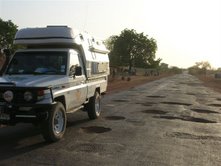
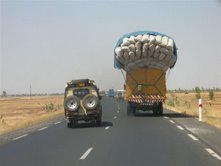
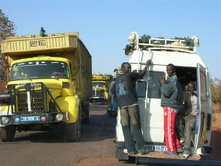
.............Potholes...............The Camel passing overloaded truck....Goats wrapped in plastic on roof
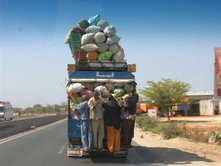


........Hitchhikers...................Timbuktu under a Baobab tree.......... ...Vehicles in Baobab forest
We see the most interesting happenings along the way. Trucks often lie belly up as they topple over, spilling their loads across the road. In Senegal, horses are more often used then donkeys to pull the carts, with owners decorating their halters with coloured streamers which blow in the breeze. We pass a goat sale market and see goats transported in many amusing ways. Some are tied and netted to the vehicle roof carriers, others are loaded onto carts wrapped in plastic with their heads popping up and others are seen being held on motorbikes and bicycles. We pass huge forests of Baobab trees which look like people about to step into the road.
DAKAR
The last 250kms of road prove to be decent tar road and we arrive on the outskirts of Dakar in late afternoon on Thursday. Dakar is a huge metropolis with a population of 2 million people. Dakar erupts as we near the inner city with masses of vehicles pushing and shoving, people trading and shops buzzing. Police wave arms frantically trying to make order from this chaos. Our convoy makes its way slowly, relying on Juno’s GPS to take us towards the airport where our hotel is located. Our heads turn like puppets as we try to take in the scenes unfolding around us.
A bicyclist volunteers to guide us to our hotel, but on arrival there we find the hotel is fully booked because of a huge Islamic Conference. Eventually we settle for rooms at Chez Maire which overlooks the Atlantic Ocean. Unfortunately the area surrounding the hotel is full of rubble and unemployed young men who hassle us every time we step out of the hotel. We are very concerned about the security of our vehicles and have a sleepless night.
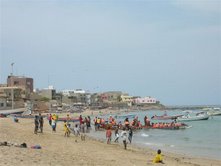

..............................Beach in Dakar..... Pam with Senegalese goat herd boy with his first book
We eat at a nearby restaurant which is frequented by many European men who appear busy entertaining beautiful long legged Senegalese girls. In fact we find this scene replaying itself in most West African countries.
VISAS
We apply for Mauritanian visas and the Consul issues them immediately with a very professional and courteous manner. The South Africans head on to the Moroccan Embassy to have a second go at getting their visas…more on this shortly.
We now await the arrival of Slowy and Charles who will arrive in Dakar on Monday night.
Return to top
______________________________________________________________________
As you may have noticed, we adjusted our itinerary to skirt around the countries of The Gambia, Guinea and Guinea Bissau. The reasons for this change of plan were based on the fact that other travelers told our group that there was not much of interest to see, police roadblocks and stops were a constant irritation, we would need to hassle with more visas and so most of the group was ready to forgo this part of the trip.
A Change of Plan
Mathew, Juno’s son, phoned us with good news this morning as he was able to negotiate Moroccan visas for our 3 South Africans. We need to DHL the passports to Johannesburg where he will take them to the Moroccan Embassy in Pretoria, get the visas entered and will return DHL them to us in Nouakchott, Mauritania. This will take 3-4 days. Juno, Garth and Gail were issued with temporary South African passports to use in Mauritania. The Mauritanian Embassy official, here in Dakar, was happy to supply them with another Mauritian visa into their temporary passports so that they could travel as far as Nouakchott where (HOPEFULLY) their permanent passports will be waiting.
So, tomorrow we are off to Mauritania. Next entry in Nouakchott! Return to top
______________________________________________________________________
SENEGAL
We wake up to find Slowy & Charles had arrived in the early hours and were waiting for us to get up. We welcome the Mitsubishi Stallion back to our convoy.
We organize our vehicles to head to the border to Mauritania. We are startled to see how many people gather around us begging for tips for services they felt they had performed for us. After we pushed and jostled our way through the morning traffic of Dakar, myriads of markets lining the roads and rubbish already stinking. Time to go!
Lac Rose
We decide to stop at the famous Lac Rose, “pink lake”, whose colour is the result of the bacteria excreting red iron dioxide. This is a beautiful sight, spoiled only by the local curio dealers pushing us in a rude way. The beach alongside the Lake is the final lap of the Paris Dakar race each year.
Zebra Bar in North Senegal
We set up camp at the Zebra Bar campsite alongside an estuary fed by the Atlantic. The camp suits us perfectly. It is managed by a Swiss couple and is clean, well run and full of interesting travelers giving us a chance to exchange information on roads and camps. We take numerous dips in the salty water to cool off in the hot afternoon.
We receive great news from Matthew, Juno’s son, to say that the visas have been stamped into the 3 SA passports, which he sent to us by DHL today. These will hopefully arrive in Nouakchott, Mauritania within 3-4 days.
St Louis
Slowy, Charles, Garth, Gail and Pam decide the visit the nearby town of St. Louis which is the oldest French Settlement in West Africa. One crosses from the mainland to the St Louis Island over a bridge which spanned the Danube River until 1897 when it was moved to St Louis. Shuttered windows, pastel coloured buildings with quaint balconies portray the French Portuguese influence. Brightly painted Pirogues (canoes) line the shore waiting for passengers while fishing boats bring in their catch of the day.
We are warned not to bring liquor into Mauritania where it is forbidden so we consume as much of our alcohol as possible and hide the rest and hope for a lax border official.
We wake up to find the resident animal menagerie waiting for breakfast….Piano, the baby donkey; Domino & Tabby, the cats and 4 robust saucy dogs. Charles arranges to have his newly chipped tooth fixed at a St Louis dentist and we pack up and head off to meet him.
On the road to Mauritania
We pass through the Senegalese border without any problems and find a change of attitude on the Mauritanian side. The officials are stern and mean business. We pay the requested border fees plus plus plus….
MAURITANIA
Yahoo we made it! Our joy is tempered by 5 successive police stops and we dish out our identity forms at each stop as well as cigarettes.
The desert covers 75% of Mauritania encroaching further each day. We traveled through the Diawling National Park and the Barrage at Diama. Flocks of pelicans and other water birds settle on the flood plains formed by the Senegal River. The hard sandy road darts off into the desert and rejoins the main road at intervals.
Gigantic cream nomadic tent towns spring up like giant mushrooms in the desert against the red desert sands. Arabic men float around in pale blue juillabayas (robes) and lounge around on the desert sand. The heat hovers at 40c+ (this is winter!) and our air conditioners battle to cope. We meet the much awaited tar road and we enter a new world. This is a world of camels (herds of camels!!), desert dunes and people. The conditions are harsh and dry and it is unbelievable to imagine that this is a place that people have chosen to inhabit. The houses are square, cement, and sometimes have colourful designs painted on them but most blend into the desert.
Nouakchott, Mauritania
We arrive at dusk to find the capital is a chaotic jumble of old model sedans barging and pushing without any consideration towards other drivers. We have not seen this style of driving since Kano, Nigeria. We battle to keep our convoy close as we search for our campground. The city is filthy and litter is piled up on centre islands on every road and the goats feed on whatever it is that goats extract from litter. People mull around as if in a trance…maybe it is the result of the intense heat. We arrive at the Auberge Sahara, a recommended camping spot to find that we need to squeeze our 5 vehicles into a tiny driveway….that is the campground!
We are all feeling the effects of the increase in temperature and the fact that we have to wait for the arrival of our passports in Nouakchott where there is not much to do and too hot to do it anyway.
We are hoping that the passports arrive tomorrow (Saturday) morning (today is a Muslim holiday) as we are ready to head to the Atar oases deep in the desert. We hope to spend 3-4 days there exploring, and then head north along the railway line road to Western Sahara.
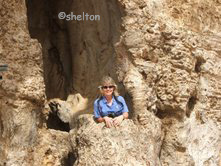
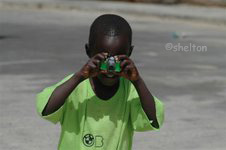
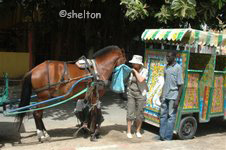
Pam inside Baobab tree...Photographer finds me a good subject .... Gail shares lunch with horse
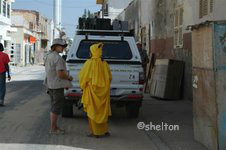
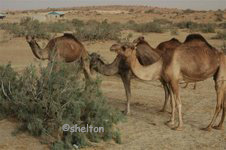
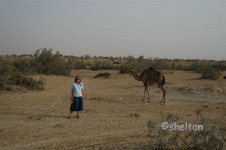
Gail chats with Senegalese lady..........Camels browsing.............Pam edging closer to wild camel
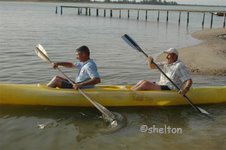
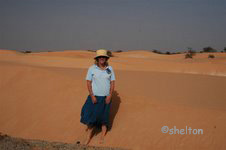
Slowy and Charles kayaking at Zebra Bar Estuary........Pam in Mauritania
...........
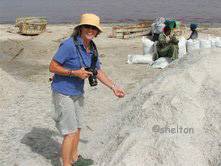
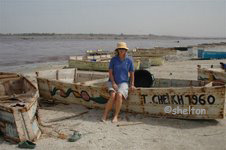
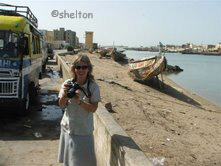
Salt at Lac Rose..............Pam at Lac Rose Salt Works........Pam at St Louis...
Return to top
__________________________________________
NOUAKCHOTT, MAURITANIA, 25 February
Hurray! The South African passports arrived by DHL envelope and the doors to Morocco are open and we can now proceed. We enjoy our short stay in Nouakchott… Pam, Gail and Charles have great fun shopping at the local shops, we try the local dinner specialty of Tagine (mutton stew cooked in a special earthenware pot) and cook some Lotte fish which we purchase at the market.
As we leave Nouakchott heading toward Atar, the desert opens its sandy gates as we leave. The scene changes as the tents of nomads dot the desert sand. The burnished black hills of the Adrar Plateau, Mauritania’s most outstanding region, lines the horizon.
We overnight at Bob Sahara Camp in Atar where we are faced with the Dutch owner’s sarcastic attitude which dampens our camping spirit momentarily. Cold salt water showers still feel comfortable after a day’s dusty desert drive. We meet many overlanders who give us tips about the route ahead of us.
The 80 km journey through the blackened Adrar is a challenging experience. The Mitsubishi develops a fuel tank leak and the chaps spend time fixing this. The Adrar Mountains prove to be our most difficult 4x4 test. The vehicles change to low ratio 4x4 and grind along the changeable roads. We climb to 700 meters up the Amogjar Pass and the ascent and decent at places are filled with boulders of all sizes making driving dangerous. Narrow paths hug the cliffs and the switchbacks are so tight that Pam, in her long wheelbase Camel, needs to execute a k turn at every corner.


Adrar stone track
With great relief we arrive at Chinguetti where we book into an Arabic style camping enclosure. We eat couscous Tagine and taste the local beverage, Hibiscus flower juice. We stroll to the village curio shops which are suffering for business because of the cancellation of the Dakar Rally. We treat ourselves to some exciting local jewelry.


Karl and Erna in Chinguetti.... Garth gets water from well
Entering the Sahara Desert
We set our minds to entering the true Sahara dunes and head toward the town of Choum which is truly the dirty backside of Mauritania. We wait for Karl to have a tyre repaired with local people hassling us continuously asking for a cadeau. We set off following the railway line through the dunes to Nouadibou, 500 km to the west. There is no map to indicate the correct track through the sand and every traveler we speak to has taken a different route. The main emphasis is to keep the railway track in sight. We also are told that live landmines are still located to the north of the railway line.

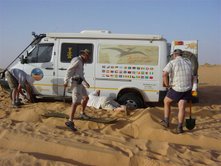

..............Repairing a puncture.... ..........Sand swallows Jet .......Camel grass for future track building
We follow a track for a full day before it comes to a full stop, taking turns getting stuck in the dunes many times. As the track ends, so does our forward progress as Juno’s Jet becomes seriously stuck involving many hours of digging and laying sand track to inch the Jet onto firm ground… We realize we have to return to Choum to refuel and start again. This time we follow Slowy and Charles and their Tracks for Africa GPS track with our heaviest vehicles to the back. The desert temperature is in the 40c range and as we have to drive in low range some vehicles overheat continuously. We leave Choum in the afternoon when the desert sand is hot and loose, causing no end of problems getting through the dunes. Our group shows great teamwork when vehicles need a repair or to be dug out of sand.
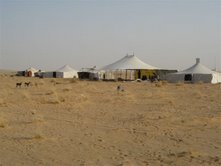
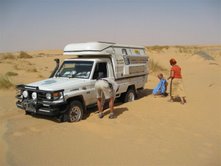
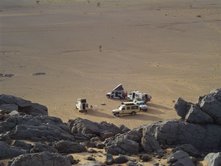
Bedouin tents............Timbuktu stuck in sand........... old habits
We camp on a high ridge in the desert which overlooks the railway line and the never ending desert dunes. We are all exhausted and after parking our vehicles in a laager, manage to put together a nice meal. Its times like this when Gail shines especially brightly as she has a knack of knowing when we should stop and set up camp and have a meal instead of battling to do those few extra kms which make people tired and cause tempers to flare. We stand to the off side of our vehicles to shower. This is an unspoken agreement to be our private shower areas.
We pass many wild camels grazing on tough camel grass and wonder whom they belong to and how can they survive in this harsh environment.
We have a day when Max has two punctures and the Jet’s steering comes loose. Garth luckily manages to find the bolt that has fallen off and saves the day. Slowy and Charles are like Bloodhounds sniffing out ahead to find the track when it disappears in the blowing sands.



Slowy cooks his famous smash.................... desert bushcamp........................... sunrise...............
After four long days in the dunes, we arrive to find a gravel road which turns to smooth tar all the way into Nouadibou.
We load Slowy onto a local bus heading for Nouakchott where he will go on to Dakar where he needs to connect with his flight to Joburg. Charles will manage the Stallion on his own now.
We book into a camp enclosure in the small dusty fishing town. We meet other travelers and exchange our experiences and get route tips. At this stage, we all have bundles of dirty laundry and we string lines on the roof of the Auberge and spend several hours washing clothes.
Exit from Mauritania to Morocco 2 March
We travel on the disputed no mans land road between the Mauritanian border with Morocco. This whole Western Saharan area has been in conflict since 1976 and is heavily land mined. The road is tar and quick and we race north. The scenery is lovely as we follow the coastline with ocean waves crashing on our left and camels and dunes to our right. We see sandstone cliffs with beautiful rock formations carved by the wind. One night we camp on the peak of a cliff with a beautiful ocean view. During the night the Harmattan wind arrives and feels like it will blow the vehicles off the cliff. There is a definite drop in temperature as we travel north.
Morocco
We begin to pass through Moroccan towns which are clean and have petrol stations with adjoining restaurants where we enjoy stopping for Arabic coffee. The largest town in Western Sahara, Laayoune, was only founded in 1940. At the entrance there is a fairyland look to the buildings which makes it look like Disneyland.
In the desert again we find a Bedouin camping area set in a valley where we enjoy a Tangine dinner served in a real Bedouin tent.
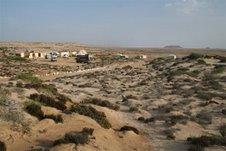
Atlas Mountains
The Atlas Mountains are divided into three regions; the Anti Atlas, the Middle Atlas and the High Atlas. We move out of the desert and begin in the Anti Atlas climbing steep and narrow roads passing through villages painted in shades of ochre. Berber ladies tend their sheep in the green lush fields of grass. We arrive in Tiznit and find that the camping area is booked full with Europeans in their huge motor homes. Europeans love their dogs so much they bring them along in their campers so the campgrounds are also full of barking excited dogs. We find another site to camp.
We continue our route into the Middle Atlas where the scenery is harsh and striking until it suddenly changes to a landscape of flowering almond trees creating a blanket of mauve and white flowers. As we round a corner on the mountain road, we find four tiny starving puppies whimpering on the roadside. After much deliberation, including a prolonged search for the mother, Pam loads the pups into The Camel and we head on to find a bush camp. The temperature drops quickly in the mountains and we make a fire to try to warm up. Garth is our fireman and is in charge of braiing all the meats. Gail and Pam detick, deflea and feed the pups who appear to be about 5 weeks old…much too young to survive on their own. We go to bed early as it is just too cold to stay up. In the morning, Charles, who sleeps on a stretcher in the open, has ice on his sleeping bag. We all shiver as we take down camp and set off towards Marrakech through the high Atlas.
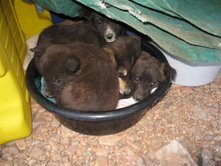
Puppies
We climb up through the Tizi n Test Pass (2092 metres) a tar road which cuts through the heart of the Atlas. It was built by the French in 1926. The pass is steep and narrow and we have to give way to oncoming traffic. We stop at a restaurant on the cliff and the owner, who seems like a kind man, is excited to provide a home for two of the puppies. It is sad to drive off to the sound of puppies crying but we cannot keep them.
Marrakech 6 March
We arrive at dusk and struggle to find a comfortable hotel. Eventually we settle a hotel on the edge of town. Pam delivers the remaining pups to the animal humane shelter and it is a great relief to have brought them to safety.
We take an open top tour bus around Marrakech and visit the souks (markets). Marrakech is a clean and well run city with beautifully designed modern buildings. It is a city where the wealthy, middle class and poorer people seem to mix easily. Tourism is Marrakech’s largest industry and tourists fill the city. We tour the Djegas El Fna Square in the old Medina where snake charmers, storytellers, palm readers and dancers keep tourists amused. A visit to the Fantasia Dinner Show to see a traditional horse dressage performance and consume a delicious meal called Mechouie (baked lamb scissored into pieces at our table and eaten with our fingers) is a highlight of our trip in Marrakech.
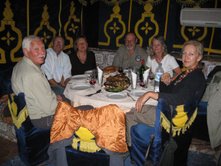

Mechouie dinner....................... Souk
Erna and Karl leave in the morning to race off to Switzerland and Germany. Our plan is to travel on to Casablanca via Fes. The drive takes us through old biblical villages in the Atlas Mountains. As we wind up narrow roads again we have a backdrop of huge snow covered mountains and acres of spring flowering plants beside the roads. We pass donkey carts, ladies selling fresh peas, orchards of olive and fruit trees and acres of wheat fields. This is truly a lush and beautiful land.
We camp at Du Barrage dam, set on a rocky outcrop overlooking an extensive lake. The night is cold and Charles experiments with different ways of setting up his stretcher to keep the wind away. We make a charcoal fire and braai Juno’s last bit of meat. We wake up to a freezing morning with no ablutions. We are quick to close up and hit the road. We pass ladies beside a stream, washing their woolen carpets which are specifically done on Sundays. We are able to see the golden fur Barbary Apes which are indigenous to the Atlas Mountains. We stop to buy fossils which are found in the Atlas in great quantities. The local people have Sunday picnics under the roadside olive trees.
Fes
Fes quickly becomes our favorite city for many reasons not the least of which is its European feel. Historically, Fes was the Imperial capital of the Moroccan Empire. It takes centre stage in Morocco with the Presidents holiday home located here and a large and modern university. It is clean without a scrap of litter to be seen. Police in immaculate and ornate uniforms are on every street corner which makes a person feel especially safe. We see no beggars or street people. We check into the Ibis Hotel and begin to explore the city. We have fun taking a local bus to visit the Fes el Bali medina (market) with its mosques and mile long labyrinth of souks. Colourful vegetable stalls are followed by shops selling everything imaginable …slippers with curled toes, jewelry, shoes, bags, silverware, rugs, linens to name a few. We take time to watch the silversmiths engraving intricate patterns on plates with artistic precision. The dye pits where leather is prepared is a vivid experience (and smell) and we browse the leather shops with new regard for leather items. As we leave the Fes el Bali, we all agree it will be a highlight of our shopping memories.
Casablanca
We drive through Rabat on our way to Casablanca. We arrive in Casablanca which is the principal city of Morocco and its capital. It was modeled by the French to resemble Marseilles. The city is a mix of old French architecture and old medina city buildings with shanties on each side of the road in the city outskirts. We book into the Hotel Kenzi Basma near the old medina market.
Our big task here is to arrange the shipping of our vehicles to Capetown and to organize our airflights to South Africa. This takes an awful lot of organization and we must thank Juno for spending so much time phoning the shippers and travel agents. We quickly realize that Maersk Shipping Line is truly professional. Their efficiency in loading the vehicles into containers resulted in our finishing the loading in about 4 hours. Juno has arranged our return flights to arrive in Johannesburg on 16 March.
13 March
We have accomplished our goal of traveling from Cameroun to Morocco in exactly 3 months. We have traveled 16,400 km and have had an amazing adventure which we have enjoyed immensely.
We experienced many cultures, met many different people, stayed in a huge variety of places and tasted the foods of many countries.
All the vehicles performed well, despite a few punctures and minor repairs.
We hope that those friends and family who have followed our website have enjoyed sharing our travel with us.
Juno & Moon King
John (Slowy) & Leony Wightman
Garth & Gail Diers
Pam Shelton
Charles Kuhn
Matthew Taylor
Dave Ringwood
Karl & Erna Rosch